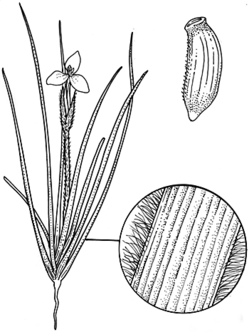Common name: Silky Purple-Flag
Patersonia sericea var. sericea R.Br. APNI* 
Description: Densely tufted perennial herb to 60 cm high.
Leaves basal, linear, sword-shaped, 15–60 cm long, 2–6 mm wide, flat to terete, finely striate, glabrous, margins pubescent to whitish tomentose near base.
Scapes 3–55 cm long, pubescent in upper part; spathes ovate to lanceolate, 2–6 cm long, prominently veined, white silky to glabrescent, dark brown to blackish; margins 1–2 mm wide, scarious, brown. Perianth tube 1.5–3 cm long; outer tepals broad-ovate, obtuse, 20–30 mm long, 15–25 mm wide, blue-violet; inner tepals ovate, c. 2 mm long. Filaments exserted 4–6 mm, fused to about two-thirds. Ovary pubescent.
Capsule ovoid-cylindrical, 15–30 mm long; seeds cylindrical, 2.5–3 mm long, brown with a waxy bloom, ridged, with large pit; aril absent.
Flowering: June–November
Distribution and occurrence: Coast, tablelands and western slopes, west to Dubbo district. Also Qld, Vic. Grows in dry sclerophyll forest, woodland and heath.
NSW subdivisions: NC, CC, SC, NT, CT, ST, NWS, CWS
Other Australian states: Qld Vic.
Text by T. A. James & E. A. Brown (1993); edited KL Wilson (May 2016); name updated by H. Sauquet (Apr 2021)
Taxon concept: Flora of NSW 4 (1993)
APNI* Provides a link to the Australian Plant Name Index (hosted by the Australian National Botanic Gardens) for comprehensive bibliographic data
***The AVH map option provides a detailed interactive Australia wide distribution map drawn from collections held by all major Australian herbaria participating in the Australian Virtual Herbarium project.
|


